The Bootlegger, Clive Cussler [black books to read TXT] 📗

- Author: Clive Cussler
Book online «The Bootlegger, Clive Cussler [black books to read TXT] 📗». Author Clive Cussler
“Where he’s been going all along,” said Isaac Bell. “Wall Street.”
Yuri Antipov had bombed a symbol of capitalism. Marat Zolner would burn its heart out with an alcohol-fueled fireball. And the Comintern would welcome the hero who incinerated New York’s Financial District the length of Wall Street from the East River to Trinity Church.
Bell stepped on the starter. The third engine fired back to life.
The battered Marion roared for New York Harbor at fifty knots.
She carried them between the arms of Sandy Hook and Rockaway Beach and up the Lower Bay in ten minutes, through the Narrows and across the Upper Bay in another seven. The third motor died at the Battery. The second in the East River under the Brooklyn Bridge.
Peering through a scrim of sheet rain, Bell spotted the tall hangars of the Loening factory and, just past it, the 31st Street Air Service Terminal. His last engine coughed, running out of gas. Fifty yards from the dock, it died. In the sudden silence, Bell disengaged the propeller to reduce drag, and she drifted close enough for Asa to loop a line around a bollard.
Bell pulled the Thompson submachine gun from a locker. “Pauline, get Ed to Bellevue. Asa, grab that box.”
“Where’d you get hand grenades?”
“Miami River. Come on!”
They ran to the Loening factory on the river’s edge. The mechanics had floated the Flying Yachts into the hangars, out of the wind. Bell climbed onto his and threw off the lines. “On the jump, boys. Open those doors and start my engine.”
“You can’t take off in this weather!” the foreman shouted.
“My mother died when I was a boy. I’ve gotten by without one since. Start my engine!”
42
BELL BATTLED HIGH WAVES taking off from the East River and ferocious gusts in the air as his flying boat climbed toward the Williamsburg Bridge. He steered between its towers, whose tops were lost in cloud, and aimed for the lowest dip in its suspension cables. He cleared them by inches. The horizon vanished in the rain.
He kept track of the horizon with a new Sperry instrument that combined a turn indicator and an inclinometer. But it was no help avoiding the Manhattan and Brooklyn bridges, much less the skyscrapers of Wall Street, and he flew blind, relying on his compass, Tank watch, and memory.
Asa Somers couldn’t stop grinning. He had never been in an airplane before.
When the Flying Yacht finally broke from the murk that enshrouded the port, Bell saw that he had already flown past the Narrows. The Lower Bay spread below him, dotted with ships. He ignored the vessels he saw at anchor. They were riding out the storm, huddled along the Brooklyn, Staten Island, and Jersey shores. Marat Zolner’s tanker would be moving, steaming up the Ambrose Channel on a relentless course toward Manhattan Island.
Bell flew the length of the channel. It was empty of ships. Had he guessed wrong? Had Zolner simply turned around and fled to Europe? When he saw Ambrose Lightship tossed violently on the storm-churned ocean, he circled back. But in the entire outer harbor he saw only one moving vessel braving the storm. Nearing the Narrows, it was, incredibly, a little rumrunner stacked with crates of whisky and sheeted in spray as it pitched and rolled.
Asa tapped Bell’s arm. He was scanning the water ahead through the binoculars. Above the Narrows, already into the Upper Bay, less than six miles from the Battery at the tip of Manhattan, a tanker was plowing toward the city. The Flying Yacht raced after it, and Bell soon recognized the Sandra T. Congdon by the tall funnel soaring from the back of her hull, her sturdy wheelhouse forward of center, her straight bow, and her graceful fantail stern. The cannon on her foredeck cinched it. Closer, he saw her crew frantically rowing away in the lifeboat. She was, indeed, a floating firebomb.
“Asa. Lash those grenades together in bundles of four.”
“Are we going to bomb him?”
“You are going to bomb those cannon shells on the foredeck. I’m going to fly the plane. See that knob on the end of the stick? That’s the detonator. Pull that knob when I tell you and drop it over the side fast as you can.”
He banked into a tight circle, straightened up behind the ship, and descended. The flying boat caught up quickly. Asa stood up in the cockpit so he could reach over the side windows. Bell soared fifty feet above the stack and over the wheelhouse, his Blériot wheel in constant motion as he tried to counteract the buffeting wind.
“Now!”
Thirty feet over the foredeck, they couldn’t miss. The bundled stick grenades landed on the cannon. They bounced onto the stacked cannon shells. But before they detonated, they skittered away and exploded with a harmless flash on the steel deck.
Bell circled for another try.
Zolner was ready with his Lewis gun. As Bell caught up with the tanker again, he flew into streaks of blue smoke. Incendiary bullets tore through his wing. Each left a trail of fire. Flames wrapped the wing.
“Seat belt, Asa, we have to land.”
“How can we stop him if we land?”
“Watch me.”
The wind, Bell thought, was blowing behind the ship, in line with her course up the channel, which would not make a dicey maneuver any easier. But slowing the plane by landing into the wind was not an option. Fanned by the slipstream, the fire enveloped the entire wing and tumbled into the passenger cabin directly behind the cockpit. He had no choice but to come down fast and hard.
• • •
OLD DONALD DARBEE stopped his oyster boat in the middle of his hurricane whisky run to see what happened next. He and little Robin had noticed the tanker proceeding up the channel when no one in his right mind but a rumrunner was out. Then the tanker’s crew lowered a boat and rowed away. But the





Comments (0)